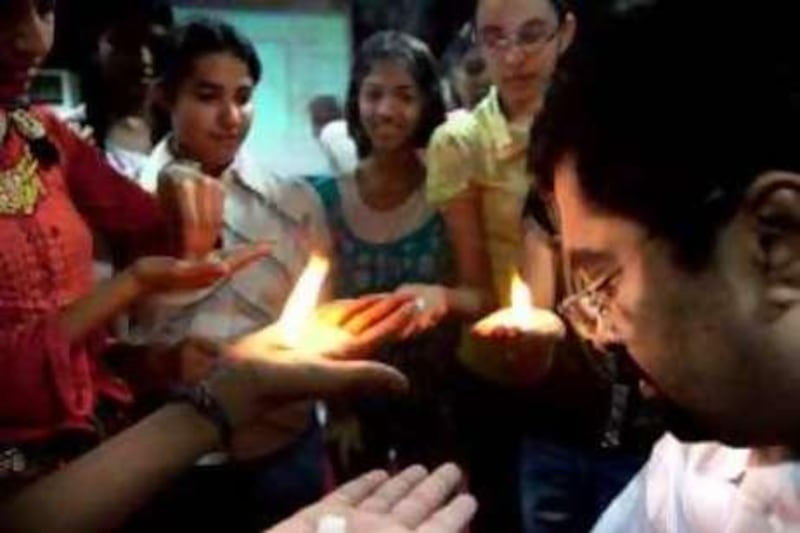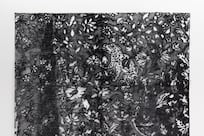NEW DELHI // At Sanal Edamaruku's feet lies a boy of 13 draped in a piece of red cloth. Mr Edamaruku calls for silence, stretches out his upturned hands and then issues a single command: levitate.
Upon that, the boy appears to float free from the floor, rise three feet in the air and hover for a few seconds, before gently descending. With his unblinking gaze and his hypnotic voice, Mr Edamaruku could be anyone of hundreds of thousands of holymen, also known as "fakirs" and "babas", across India who claim to be able to perform such miracles. Only he is not. In fact, as head of the Indian Rationalist Association, Mr Edamaruku spends his time exposing these people as part of his mission to bring about an Indian Enlightenment.
"The goal I have is to stop these fraudulent babas and gurus," Mr Edamaruku said. "Despite our phenomenal progress, superstition and obscurantism are still strong in our country. These people have huge power over the lives of many Indians." To diminish that power, Mr Edamaruku is running a course at Delhi's National Science Centre this month titled "The Science Behind Miracles", where he teaches schoolchildren how tricks such as levitation are performed.
The idea is to foster a healthy scepticism in the next generation of teachers, leaders and managers and a desire to seek scientific rather than mystical explanations when faced with seemingly inexplicable phenomena. "We want these children to be ambassadors of change," Mr Edamaruku said. "We want them to go home and show their friends and families what they have learnt." Religion and superstition have a long and rich history in India. Three of the world's six major faiths were founded here and the country has more temples than it does schools.
The country's large population, high levels of poverty and low levels of education produce the perfect conditions for old wives' tales and superstitious beliefs to endure. During a recent solar eclipse, families buried handicapped children up to their necks in earth in the belief that it would cure them. Indian newspapers often contain stories of people carrying out human sacrifices to conceive, obtain occult powers or achieve business success.
Experts say the decentralised nature of India's main religion, Hinduism, also plays a role because there is almost no regulation of religious practice or the actions of those who claim to represent it. As a result, anyone can set themselves up as a guru offering advice on matters ranging from the spiritual, to health or money. In March, Delhi police arrested Shiv Murat Dwivedi, a former security guard turned guru, for running a multimillion-dollar prostitution ring out of his religious headquarters. Last month, police finally caught up with Paramahamsa Nithyananda, a self-styled guru from Bangalore who was wanted on charges of rape and sexual exploitation of his devotees, and fraud.
"These people are criminals and conmen. They are hiding behind religion," Mr Edamaruku said. "We have two Indias - one 21st-century India and one 16th-century India. The 16th-century India is holding the 21st-century India back." The levitation trick is simulated by lying on the floor under a blanket and then sitting up slowly while holding out two hockey sticks to mimic the rising of the legs and feet.
Another "miracle", in which godmen make rocks explode simply by sprinkling holy water on them, is achieved by embedding sodium crystals in the rocks, which expand rapidly on contact with water. Likewise, a trick where a fakir is able to create fire by pouring ghee, or clarified butter, on a pile of wood and staring at it, is accomplished because the ghee is actually glycerine and the wood has been sprinkled with potassium permanganate. The two chemicals react and combust a few minutes after coming into contact.
Exposing these fake babas can be dangerous, however. "I have never felt threatened by the members of the public, but the babas have attacked me," Mr Edamaruku said. One fakir threw a pot of burning coals in Mr Edamaruku's face when he revealed how the tantric was able to hold it without burning himself. Another time, the state government in Kerala tried to arrest him after he discovered that officials at the famous Sabarimala temple were faking lights in the sky, which draw millions of pilgrims - and generate millions of dollars of revenue - every January.
Most famously, though, Mr Edamaruku agreed to participate in a live television show where a famous tantric tried to kill him using black magic. The show was one of the most watched in Indian television history and when the godman failed, his career was in tatters. In the past, the Rationalists concentrated their activities on rural communities, thinking that superstition would fade naturally in the cities.
Of late, Mr Edamaruku has become worried by the degree to which many wealthy urban Indians continue to embrace these beliefs. "There is a popular misconception that superstition only exists in rural areas but superstition is thriving in well-educated, urban middle class families as well," Mr Edamaruku said. The godmen who were arrested recently both had middle- and upper-class clients and a few weeks ago it emerged that a Delhi high school had hired an astrologer to give careers advice to graduating students.
Modern life, with all its pressures, may be even contributing to the phenomenon. Few urban Indians have the time to do long pujas (prayer ceremonies) or go on pilgrimages any more, yet with competition for good jobs and places at India's leading universities high, many people feel the services of private gurus or a numerologist might just give them the edge. Hence the course, which covers everything from miracles to numerology and astrology.
"I want these children to realise that if they get good exam results, it is because they have worked hard not because their parents have paid for a godman to do a puja. "I want people to make their own decisions. They should not be guided by ignorance, but by knowledge." One area where he chooses to tread lightly, however, is religion. He is mindful of the fact that many of the children who attend the course come from religious homes. So far, not one child has been withdrawn from the course, which lasts five days, and which has been running on a weekly cycle since May 17. In fact the last week, which starts today, is oversubscribed.
foreign.desk@thenational.ae





